
|
|

February 23, 2007
The Big Trip 2006, Part III: Corvallis and Salem, OR
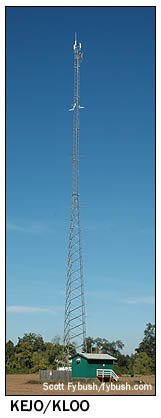 Once
every year or so, when finances and schedules permit, your editor
and a couple of his similarly-obsessed radio pals get together
to spend a week or so exploring a corner of our great nation,
packing our schedules as full as possible to visit as many interesting
broadcast facilities as we can.
Once
every year or so, when finances and schedules permit, your editor
and a couple of his similarly-obsessed radio pals get together
to spend a week or so exploring a corner of our great nation,
packing our schedules as full as possible to visit as many interesting
broadcast facilities as we can.
And then, a few months later, once we've caught our breath (and some much-needed sleep), we share it all with you here on Tower Site of the Week (and in audio form over on Tophour.com) in a feature we call "The Big Trip."
The 2006 version of the Big Trip began and ended in Seattle, and along the way took us as far south as Eugene, Oregon and as far east as Coeur d'Alene, Idaho.
Day Two - Friday, September 22
With our whirlwind survey of the sites of Eugene wrapped up, there's still a lot of ground we want to cover before the first full day of the Big Trip draws to a close - 150 miles or so of driving that will take us north to Portland and then west to the coast and our weekend stop in Seaside.
Heading north out of Eugene, it's about 35 miles to another big college town, Oregon State University's home base in Corvallis. With an appointment to keep, we don't spend long in downtown Corvallis, instead making our way north along US 20 as it follows the bends in the Willamette River to our first stop, the diplexed tower that holds two of Clear Channel's AMs in town. KEJO (1240 Corvallis) does sports as "1240 Joe," while KLOO (1340 Corvallis) is the news-talker, "NewsRadio 1340 KLOO-AM" (and yes, they do say it like "Clue"!)
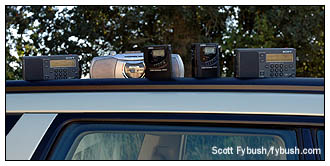 These
stations are part of a six-station group that extends east to
the nearby towns of Albany and Lebanon, including progressive
talk KTHH (990 Albany, since flipped to classic country) and
three FMs: country KRKT-FM (99.9 Albany), classic rocker KLOO-FM
(106.3 Corvallis) and rocker KFLY (101.5 Corvallis). Maybe someday
we'll get back to the area with more time to see these, as well
as the other big stations in the market: Marathon's country KXPC-FM
(103.7 Lebanon), Eads Broadcasting's standards KSHO (920 Lebanon)
and news-talk KGAL (1580 Lebanon), religious KWIL (790 Albany)
and KHPE (107.9 Albany), small-town KFIR (720 Sweet Home) and
Oregon State's student station, KBVR (88.7 Corvallis).
These
stations are part of a six-station group that extends east to
the nearby towns of Albany and Lebanon, including progressive
talk KTHH (990 Albany, since flipped to classic country) and
three FMs: country KRKT-FM (99.9 Albany), classic rocker KLOO-FM
(106.3 Corvallis) and rocker KFLY (101.5 Corvallis). Maybe someday
we'll get back to the area with more time to see these, as well
as the other big stations in the market: Marathon's country KXPC-FM
(103.7 Lebanon), Eads Broadcasting's standards KSHO (920 Lebanon)
and news-talk KGAL (1580 Lebanon), religious KWIL (790 Albany)
and KHPE (107.9 Albany), small-town KFIR (720 Sweet Home) and
Oregon State's student station, KBVR (88.7 Corvallis).
For now, though, our primary contact with all those stations is over the air, as our array of radios and tape decks (above left) gets set up a few minutes before 3 to record as many top-hour IDs for us to post over at our sister site, Tophour.com, where the sounds of Corvallis and Salem will greet you beginning Wednesday, Feb. 28. (And no, that's not even the full lineup - there were a couple more tape decks in action inside the car...)
And where's that car sitting? It's parked at our next destination, a few miles up US 20 from KEJO/KLOO, tucked back on a side road at Oregon State's Test Field Lab north of Corvallis. This is Oregon Public Radio's KOAC (550 Corvallis), one of the most unusual transmitter sites in America.
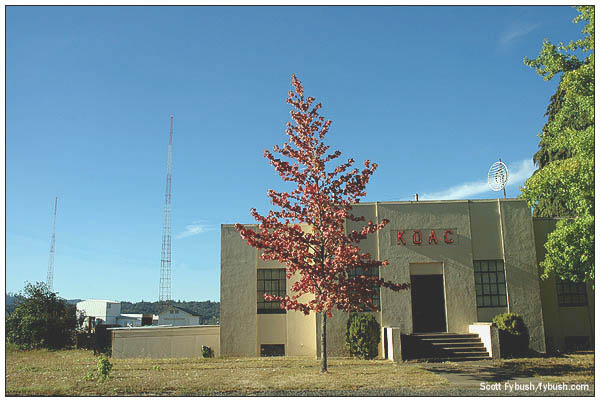
There's a fascinating history to be written someday about all the early educational radio stations that sprouted in the 1920s, mostly at land-grant universities. The usual examples that come to mind are mainly in the Midwest - WILL at the University of Illinois, WBAA at Purdue University, WOI at Iowa State, WSUI at the University of Iowa, KSAC at Kansas State, and so on.
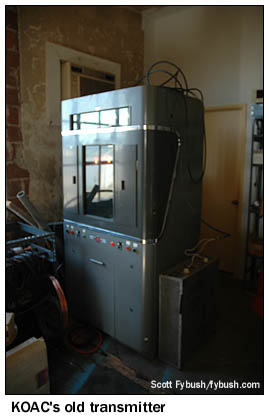 But
the movement extended as far as the West Coast, and in particular
to Corvallis and what was then the Oregon Agricultural College,
which put KFDJ
on the air with 50 big watts on December 7, 1922.
But
the movement extended as far as the West Coast, and in particular
to Corvallis and what was then the Oregon Agricultural College,
which put KFDJ
on the air with 50 big watts on December 7, 1922.
 KFDJ
took the college's initials for its calls in 1925, and in 1941
its transmitter moved off campus to a new Art Deco building on
the experimental farm at Granger, seven miles to the north.
KFDJ
took the college's initials for its calls in 1925, and in 1941
its transmitter moved off campus to a new Art Deco building on
the experimental farm at Granger, seven miles to the north.
From the new site, KOAC increased its power from 1 kW to 5 kW, installing a new two-tower directional array to protect the only other stations then on 550 west of the Mississippi, in St. Louis, Bismarck, Phoenix and San Antonio.
(KOAC was unusually lucky in the allocations game; while most of the educational stations in the Midwest and East ended up as daytimers or in uncomfortable share-time situations, the Oregon station managed to keep its channel to itself, full-time, on a nice low frequency that covered most of the state's population by day. Even today, it's easily audible 65 miles north in Portland and 40 miles south in Eugene.)
Over the decades that followed, KOAC sprouted a TV station, KOAC-TV (Channel 7). Its debut in 1957 eventually grew into a statewide educational TV network that's now Oregon Public Broadcasting. In 1981, OPB became independent from the state's university system, and today, while KOAC maintains a studio at Oregon State, it's the lone AM signal in what's otherwise an FM network based in Portland at KOPB-FM (91.5) and extending east to the Idaho state line and south down the coast to Tillamook. (With the plethora of public radio choices already available in Eugene and to the south in Medford and vicinity, OPB Radio has never extended itself down I-5 to that region, though OPB-TV is on the air as far south as Eugene and Roseburg.)

|
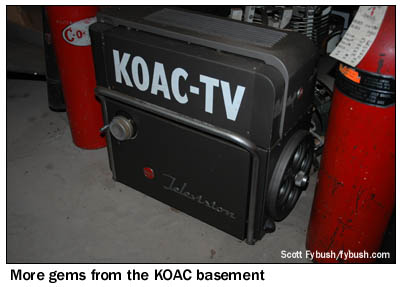
|
From the outside, the KOAC building today looks pretty much just as it did 65 years ago, right down to the neon call letters above the door that still light up. Inside, the old tube transmitters have given way to a modern solid-state BE AM6A transmitter, which sits next to the phasor in a main transmitter room that's now used largely for storing surplus office equipment and other gear. Out of frame to the right, there's a Sparta backup transmitter that served as the main until 2005, and in the back room there's a beautiful old Collins that still makes power, though it's not often used.
Down in the basement, we find a treasure trove of even older KOAC gear, including a console once used for remote broadcasts and an early KOAC-TV camera, which, to judge by its age, was probably a hand-me-down from one of Oregon's commercial TV stations around the time Channel 7 signed on in the late fifties.
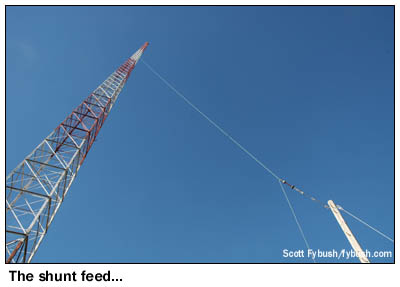
|
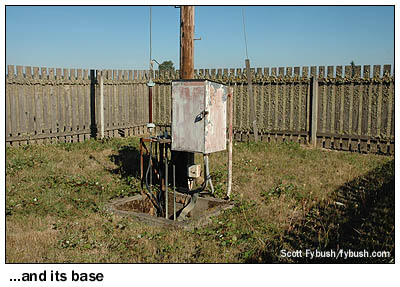
|
 All
this history is neat, but by itself it's not enough to make KOAC
one of the most unusual sites we've ever seen. No, that distinction
comes from a drive out back, into the experimental farm and over
to the base of one of the pair of 325-foot towers that went up
in 1941.
All
this history is neat, but by itself it's not enough to make KOAC
one of the most unusual sites we've ever seen. No, that distinction
comes from a drive out back, into the experimental farm and over
to the base of one of the pair of 325-foot towers that went up
in 1941.
Unlike most towers, even then, these towers were built with grounded bases and shunt-fed, and today they make up, as far as I'm aware, the only shunt-fed AM directional array in the country.
At one time, such shunt feeds were a fairly common method of feeding an AM tower. As you can see in the photo above, the feedline from the transmitter building comes into a pit next to the tower, then up to the ATU, up into the air, and out in a sweeping diagonal to a point about three-quarters of the way up the tower. The result is an AM tower you can walk right up to and lean against, as our tour guide, KOAC engineer Pete Hoegg, demonstrates.
The FCC no longer allows new shunt-fed installations, since its modeling software has a hard time dealing with them, and today the standard method for putting an AM station on a grounded tower is the folded unipole, which (to oversimplify things, perhaps) essentially folds the feedline of a shunt-fed antenna parallel to the tower.
One quirk to the shunt-fed DA here, by the way: it's essentially IBOC-proof, or at least so said the consultants who evaluated all the public radio AM facilities in the country to see how easily they could be converted to HD Radio. For KOAC to make that change would probably mean a whole new antenna system, and there's little likelihood of that happening.
After a most enjoyable visit with Pete at the KOAC site, we've still got a lot of driving to do, and not that much daylight, so we regretfully pass up the stations in Albany and Lebanon in favor of another 20 miles or so north on I-5 to the state capital of Salem.
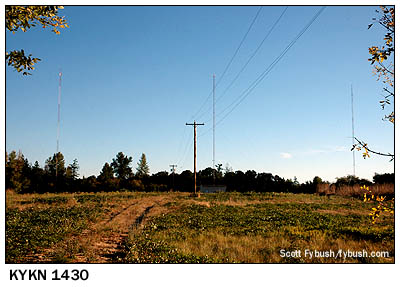 On
the fringes of the Portland radio market, the FM dial in Salem
has pretty much entirely migrated north to the state's biggest
city, leaving only little KSND (95.1 Monmouth) as a "Salem"
FM signal, along with several AMs. With time running short, we
only make it to two of those four AMs - local news-talker KYKN
(1430 Keizer), with a directional array on the city's east side,
and religious KCCS (1220), with a tower so nondescript that we
don't even stop for a picture.
On
the fringes of the Portland radio market, the FM dial in Salem
has pretty much entirely migrated north to the state's biggest
city, leaving only little KSND (95.1 Monmouth) as a "Salem"
FM signal, along with several AMs. With time running short, we
only make it to two of those four AMs - local news-talker KYKN
(1430 Keizer), with a directional array on the city's east side,
and religious KCCS (1220), with a tower so nondescript that we
don't even stop for a picture.
The other two AMs are over on the west side of the Willamette - Entercom's KSLM (1390), simulcasting oldies KKSN (910 Vancouver WA) from Portland, and local oldies KBZY (1490) - but time's short, and our drive is long, so we settle for a quick pass by Oregon's 1930s-vintage Art Deco state capital building before pushing on north to Portland for dinner, and then on to a late-night arrival on the coast in Seaside for the International Radio Club of America's annual convention.
(A quick note on KSLM: a few months after our visit, it took the KKSN calls when Entercom turned off the oldies and sold the 910 facility to Salem - the broadcaster, not the city. What's now KKSN 1390 in Salem now relays Entercom's Portland sports station, KFXX 1080. In a few weeks, we'll show you both of those Portland AM sites, too.)
In our next installment, we'll share some pictures and stories from our weekend on the beautiful Oregon coast - and in the meantime, join us over at Tophour.com for a selection of Corvallis/Albany and Salem IDs, beginning on February 28!
 The Tower Site
Calendar 2007 is here! They're going to sell out, just like
2006 did - order today at the Fybush.com
Store!
The Tower Site
Calendar 2007 is here! They're going to sell out, just like
2006 did - order today at the Fybush.com
Store!
- Previous Site of the Week: Eugene, Oregon
- Next Week: Astoria, Seaside and Tillamook, Oregon
- Site of the Week INDEX!
- How can you help support Site of the Week? Click here!
- Submit your suggestions for a future Site of the Week!
